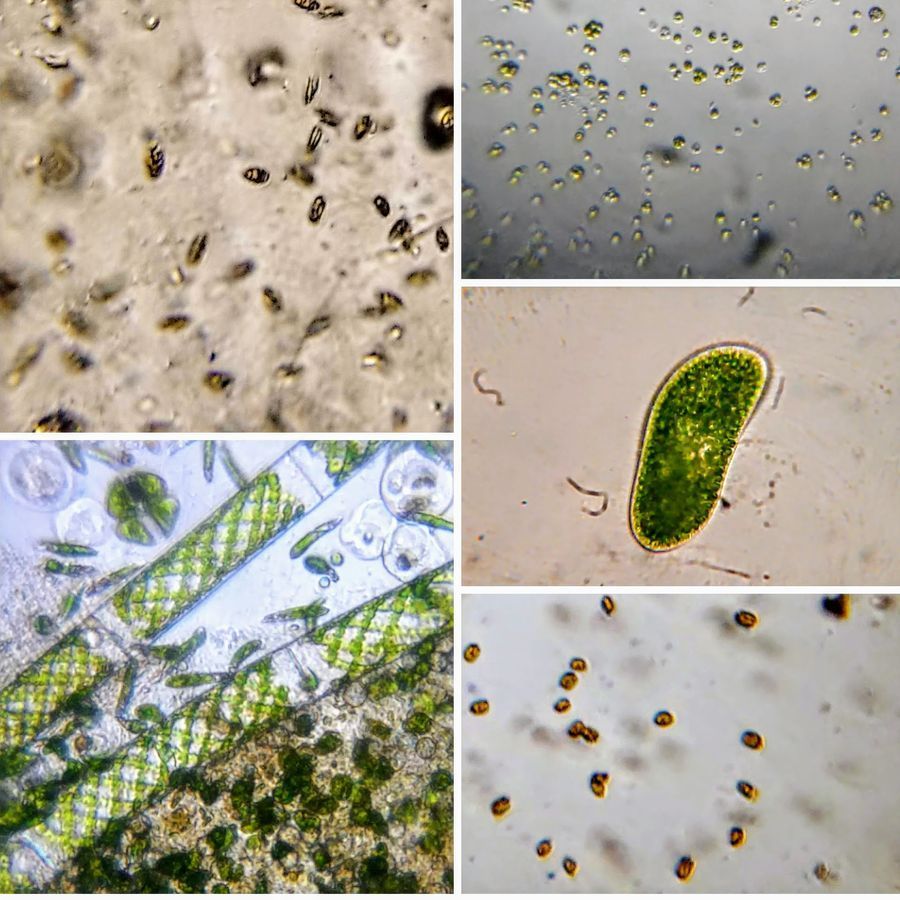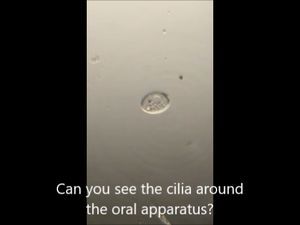III. Understanding the earliest farmers: Secondary endosymbiosis, Matryoshka dolls
 Feb 27, 2023 • 6:14 AM UTC
Feb 27, 2023 • 6:14 AM UTC United States
United States 140x Magnification
140x Magnification Plants
Plants
Laks Iyer
Human observer of life. https://sukshmadarshin.wordpress.com
97posts
1255comments
5locations

In my previous two posts, we explored cyanobacteria and the green algae, some of which were closest to the ancestors of the land plants. The engulfment of a cyanobacterial ancestor of the chloroplast by a eukaryote led to the evolution of the rhodophytes, glaucophytes, and green plants. This is called the primary endosymbiosis event .
These are the previous two posts on them.
https://microcosmos.foldscope.com/?p=transfer_197632
https://microcosmos.foldscope.com/?p=NTRTDTxFzFlgDPd6RlPP
These eukaryotes and especially the green plants and the red alga were often acquired secondarily by other eukaryotes. This is called secondary endosymbiosis and here is where we can see the whole range of the stages of secondary endosymbioses across the eukaryotic world. We can imagine the process as having multiple steps.
Step 1. Consumption of plants/algae . I took this video from an old post of mine. A Tetrahymena vorax macrostome (large mouthed) gobbling Chlamydomonas . This process is very common across life. They all eat their veggies. Whereas I could of course just show you my video eating my veggies :-) but that would be inappropriate as it isnt the correct scale of the microcosmos (PJ).
These are the previous two posts on them.
https://microcosmos.foldscope.com/?p=transfer_197632
https://microcosmos.foldscope.com/?p=NTRTDTxFzFlgDPd6RlPP
These eukaryotes and especially the green plants and the red alga were often acquired secondarily by other eukaryotes. This is called secondary endosymbiosis and here is where we can see the whole range of the stages of secondary endosymbioses across the eukaryotic world. We can imagine the process as having multiple steps.
Step 1. Consumption of plants/algae . I took this video from an old post of mine. A Tetrahymena vorax macrostome (large mouthed) gobbling Chlamydomonas . This process is very common across life. They all eat their veggies. Whereas I could of course just show you my video eating my veggies :-) but that would be inappropriate as it isnt the correct scale of the microcosmos (PJ).
Step 2. Retention of algae and symbiosis. Many organisms try to retain the algae they consume in such a way that the photosynthesizing algae provide them with a readymade food source. However, this association may not be completely binding in the sense that they might be "cured" of the algae or might lose them regularly hence needing to feed on them for replishment. One dramatic instance of this I have studied is in the ciliate Paramecium bursaria . I had written a couple of posts on it.
https://microcosmos.foldscope.com/?p=transfer_133484 . Below is another video on the same. This Paramecium has enclosed in its vacuoles a green alga called Zoochlorella . People have successfully "cured" the Paramecium of the alga and even reinfected it with another species. On a side note, this organism is perhaps one of the easiest to maintain. I caught it in a pond some 3-4 years ago and I periodically replenish the bottle with some fresh spring water. The availability of its own food means that with some minor nutrients such as salts that are present in plenty in Spring water, and light, it grows without much fuss.
https://microcosmos.foldscope.com/?p=transfer_133484 . Below is another video on the same. This Paramecium has enclosed in its vacuoles a green alga called Zoochlorella . People have successfully "cured" the Paramecium of the alga and even reinfected it with another species. On a side note, this organism is perhaps one of the easiest to maintain. I caught it in a pond some 3-4 years ago and I periodically replenish the bottle with some fresh spring water. The availability of its own food means that with some minor nutrients such as salts that are present in plenty in Spring water, and light, it grows without much fuss.
On the same point, I don't know if you have seen this wonderful post. https://microcosmos.foldscope.com/?p=transfer_29923 . Here an acoelomorph worm holds on to an alga and moves towards light to feed the alga and itself. There is a dramatic video demonstrating it in the post. In fact there are several dramatic examples of secondary endosymbiosis or attempts at it. The sea slug Elysia punctures plant cells and steals the chloroplasts from them and stores them in their intestines so that they get readymade food. It's a strange world indeed.
Step 3. Firming up the endosymbiotic event . Euglena belongs to a eukaryotic clade called the Euglenozoa that also includes parasites such as the sleeping sickness causing Trypanosoma . The free-living Euglenozoans or Euglenids have permanent endosymbiotic algae, also called chloroplast. When people first studied the membrane structure of these chloroplasts they realized Eugelnid chloroplasts had three membranes and hypothesized that this was actually a eukaryotic alga that was swallowed by an ancestral Euglenid and not a plant chloroplast. This has been since confirmed by genome sequencing. BTW, I heard that people are able to cure the Euglena from its chloroplasts and can maintain it with proper nutrition but I am not sure they can reinfect it with another alga. Although Euglena is not phagocytic, it can show a great range of shape changes during movement and this is called metaboly. This is because unlike a plant, it doesn't have a cell wall but an external protein pellicle that allows it to changes shapes as shown. I record this in the video below.
Step 3. Firming up the endosymbiotic event . Euglena belongs to a eukaryotic clade called the Euglenozoa that also includes parasites such as the sleeping sickness causing Trypanosoma . The free-living Euglenozoans or Euglenids have permanent endosymbiotic algae, also called chloroplast. When people first studied the membrane structure of these chloroplasts they realized Eugelnid chloroplasts had three membranes and hypothesized that this was actually a eukaryotic alga that was swallowed by an ancestral Euglenid and not a plant chloroplast. This has been since confirmed by genome sequencing. BTW, I heard that people are able to cure the Euglena from its chloroplasts and can maintain it with proper nutrition but I am not sure they can reinfect it with another alga. Although Euglena is not phagocytic, it can show a great range of shape changes during movement and this is called metaboly. This is because unlike a plant, it doesn't have a cell wall but an external protein pellicle that allows it to changes shapes as shown. I record this in the video below.
On the same lines, some ancestors consumed a red alga instead. For example the ancestor of a vast clade of eukaryotes called SARs was inferred to have consumed a red alga which exists as an endosymbiont in them. SARs includes Stramenopiles (e.g. diatoms), Alveolates (cilitates and relatives such as the malaria disease causing Apicomplexans), Rhizarians and Cryptomonads. A lot of videos in microcosmos include members of this group (e.g. ciliates) and so I shall try to show some that are somewhat rare in our website. In my next video, I show a dinoflagellate (an alveolate) called Amphidium . This is somewhat reddish in color too.
Chilomonas is a member of the Cryptomonad family (which is part of the SAR group). It has a plastid, only that it is colorless and hence called a leucoplast. These are extremely easy to grow and grow to high density. I often used them as feed for my Amoebae . They also show an interesting behavior I have reported for another ciliate. Click here to read it . I called it Saltation, but essentially, some organisms in the sample rest for some period of time and then by some unknown cause zoom off at top speed. Perhaps they are stuck on the coverslip or perhaps there is something more to this.
BTW there is Tertiary endosymbiosis too where these organisms are further engulfed by others. Reminds me of the matryoshka dolls.
P.S. Can you find other such examples of symbiotic associations in the microbial world? One that I know and plan to see soon is the fern Azolla , where a cyanobacterium lives intracellularly in the fern. Since the bacterium fixes nitrogen for the plant, the fern can rapidly grow in pond as it has everything it needs in itself. It is used as a fertilizer and feed in some countries.
P.S. Can you find other such examples of symbiotic associations in the microbial world? One that I know and plan to see soon is the fern Azolla , where a cyanobacterium lives intracellularly in the fern. Since the bacterium fixes nitrogen for the plant, the fern can rapidly grow in pond as it has everything it needs in itself. It is used as a fertilizer and feed in some countries.
Sign in to commentNobody has commented yet... Share your thoughts with the author and start the discussion!

 0 Applause
0 Applause 0 Comments
0 Comments_300x300.jpeg)

















